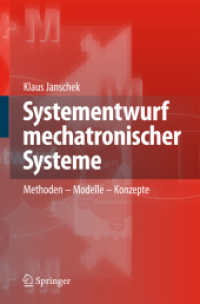基本説明
The book examines DDs found in literature and engineering practice and provides insights into relationships between DDs and different polynomial or spectral expressions for representation of discrete functions.
Full Description
Decision diagrams (DDs) are data structures for efficient (time/space) representations of large discrete functions. In addition to their wide application in engineering practice, DDs are now a standard part of many CAD systems for logic design and a basis for severe signal processing algorithms. Spectral Interpretation of Decision Diagrams derives from attempts to classify and uniformly interpret DDs through spectral interpretation methods, relating them to different Fourier-series-like functional expressions for discrete functions and a group-theoretic approach to DD optimization. The book examines DDs found in literature and engineering practice and provides insights into relationships between DDs and different polynomial or spectral expressions for representation of discrete functions. In addition, it offers guidelines and criteria for selection of the most suitable representation in terms of space and time complexity. The work complements theory with numerous illustrative examples from practice. Moreover, the importance of DD representations to the verification and testing of arithmetic circuits is addressed, as well as problems related to various signal processing tasks.
Contents
Signals.- Algebraic Structures for Signal Processing.- Spectral Techniques.- Fourier Analysis on Groups.- Spectral Interpretation of Decision Diagrams.- Advanced Topics in Decision Trees and Diagrams.- Optimization of Decision Diagrams.- Word-Level Decision Diagrams.- Spectral Interpretation of Edge-Valued Decision Diagrams.- Spectral Interpretation of Ternary Decision Diagrams.- Group Theoretic Approach to Optimization of Decision Diagrams.- Closing Remarks.
-

- 電子書籍
- 八神先生はぽっちゃりボディを育てて(性…
-

- 電子書籍
- 古竜なら素手で倒せますけど、これって常…
-

- 電子書籍
- イケメンだから愛せない12 comic…
-

- 電子書籍
- 愛は試練に満ちて【分冊】 1巻 ハーレ…




